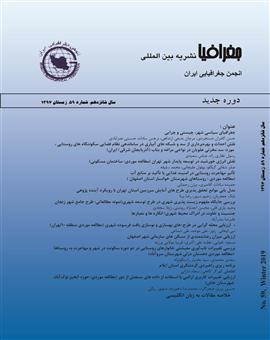نقش انرژی خورشید در توسعه پایدار شهر تهران (مطالعه موردی: ساختمان مسکونی)
محورهای موضوعی :صابر شفائی گیگلو 1 , بهلول علیجانی 2 , محمد سلیقه 3
1 - علوم جغرافیایی دانشگاه خوارزمی
2 - دانشگاه خوارزمی
3 - علوم جغرافیایی
کلید واژه: توسعه پایدار, انرژی خورشیدی, سیستمهای فتوولتائیک, شهر تهران,
چکیده مقاله :
نیاز بشر به انرژی، پیوسته در حال افزایش و منابع انرژی فسیلی رو به کاهش است. استفادهی بیرویه از منابع سوخت فسیلی با آلوده ساختن محیطزیست، زندگی در کرهی زمین را تهدید میکند و امروزه یکی از راهکارهایی که برای بحران انرژی پیشنهاد میشود، در کنار اصلاح الگوی مصرف، استفاده از انرژیهای تجدیدپذیر است. انرژی خورشیدی از جمله انرژیهای تجدیدپذیر است و از مولفههای اصلی توسعه پایدار محسوب میشود. این پژوهش، به بررسی و شناخت پتانسیل انرژی خورشیدی و عوامل موثر در جایگزینی آن با سوختهای فسیلی، خصوصا در بخش ساختمانهای مسکونی در شهر تهران پرداخته است و از حیث هدف، کاربردی و از حیث نوع، توصیفی ـ تحلیلی است و از 4 مرحلهی اصلی تشکیل شده است: در مرحلهی نخست، جهت شناسایی و بررسی وضعیت موجود انرژی تولیدی و مصرفی، به مطالعه، بررسی و مقایسهی دادههای مربوط به مصرف انرژي حاصل از کلیه سوختهای فسیلی، انرژیهای تجدیدناپذیر و تجدید، در مرحله دوم، پتانسل انرژی خورشیدی در شهر تهران با استفاده از اطلاعات بدست آمده از ایستگاه سینوپتیکی مهرآباد شهر تهران، در مرحله سوم به بررسی وضعیت عملکردی و هزینه زیرساخت لازم جهت بهرهبرداری سیستمهای فتوولتائیک در مقایسه با سوختهای فسیلی، پرداخته شد و درمرحله آخر، فرآیند طراحی و تحلیل نحوه انتخاب سیستم فتوولتاییک با اجرا بر روی یک سیستم نمونه تشریح شده است. نتایج حاکی از آن است که با توجه به شرایط توپوگرافی و موقعیت جغرافیایی، شهر تهران دارای ظرفیت بالای انرژی خورشیدی میباشد که زمینههای بهرهمندی از توسعه پایدار را در این شهر فراهم میکند. همچنین نتایج نشان داده که در ساختمان مسکونی مورد مطالعه استفاده و فعالسازی سامانههای فتوولتائیک خورشیدی سودآوری اقتصادی قابل ملاحظهای داشته که خود بستری برای دستیابی به توسعه پایدار است.
Sustainable urban development is about building a relatively ideal and ideal city in which contemporary citizens enjoy a fairly good life and the future generation's ability to meet their needs. Tehran, as the main city in Iran, which has about 20% of the country's population and its changes are influenced extensively and directly throughout the country, should therefore be considered more than other cities in terms of urban development. This research is practical in terms of purpose and in terms of its type, descriptive-analytical and consists of four main stages. In the first phase of this research, in order to identify and assess the current status of produced and consumed energy, we study and compare energy consumption data from all fossil fuels, non-renewable and renewable energy sources. In the second stage, the solar energy potential in Tehran, was studied using the information obtained from the synoptic station Mehrabad. In the third step, the cost of generating energy (electric energy) with fossil fuels or photovoltaic systems was compared. In the final stage, the process of designing and analyzing the choice of photovoltaic systems with run on two sample systems was implemented. The results indicate that the domestic, commercial and public sectors and transportation have the highest energy consumption in Tehran in different parts of the country. And also these two parts form the main part of energy consumption in residential areas. as of 2014, the total supply of energy (including production, imports, ...) of non-renewable fossil fuels is 1.774.5 million barrels of crude oil. As of 2014, the total supply of energy (including production, imports, ...) of non-renewable fossil fuels is 1.774.5 million barrels of crude oil. By contrast, the total supply of renewable energy, especially solar energy, is only 24.9% (equivalent to crude oil barrels), which is only 0.013% of the total energy supply of the country. However, due to high capacities of different energy standards in Tehran, utility rate of solar energy this city is significant. And luckily, in recent years, there has been a downturn in the cost of photovoltaic systems. Therefore, at the end of the research, suggestions were made to enhance the role of solar energy in the sustainable development of Tehran, especially in the construction industry, contains: review and modification of urban planning rules for optimizing energy consumption of fossil fuels, by notification and coercion new guidelines for the use of solar energy in the residential areas of Tehran. Culture -building and development of incentive schemes for the prosperity of the production and use of solar energy by citizens, even in small quantities. Providing necessary infrastructure for utilizing solar energy in the household, public and commercial sectors of Tehran
